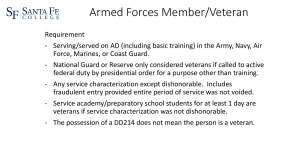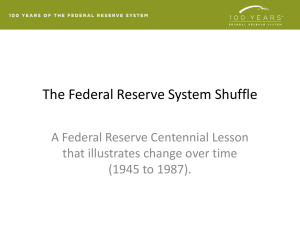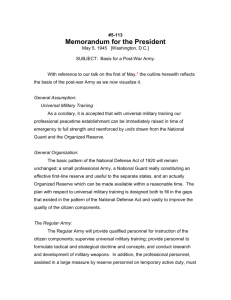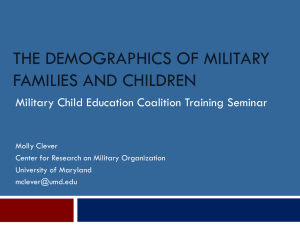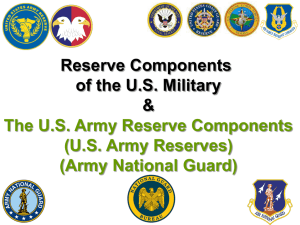PowerPoint Handout March 2012 - liuna
advertisement
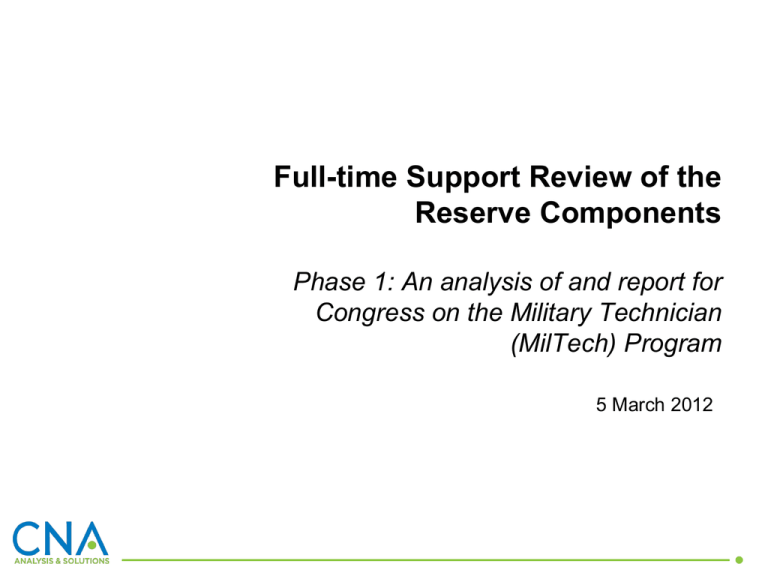
Full-time Support Review of the Reserve Components Phase 1: An analysis of and report for Congress on the Military Technician (MilTech) Program 5 March 2012 Background • ASD-RA requested that CNA conduct a review of the full-time support (FTS) force and mix necessary to sustain the future operational reserve • The study has 4 phases: – Phase 1: An analysis of and report for Congress on the Military Technician (MilTech) program as required by section 519 of the National Defense Authorization Act (NDAA) for FY 2012 – Phase 2: A review of the Army National Guard, Army Reserve, and Marine Corps Reserve FTS programs, to begin during the second half of FY12 – Phase 3: A review of the Navy and Coast Guard FTS programs, to begin in FY13 – Phase 4: A review of the Air National Guard and Air Force Reserve FTS programs, to begin in FY14. 2 Section 519, NDAA for FY 2012 SEC. 519. REPORT ON TERMINATION OF MILITARY TECHNICIAN AS A DISTINCT PERSONNEL MANAGEMENT CATEGORY. (a) INDEPENDENT STUDY REQUIRED.—The Secretary of Defense shall conduct an independent study of the feasibility and advisability of terminating the military technician as a distinct personnel management category of the Department of Defense. (b) ELEMENTS.—In conducting the study required by subsection (a), the Secretary shall— (1) identify various options for deploying units of the Selected Reserve of the Ready Reserve that otherwise use military technicians through use of a combination of active duty personnel, reserve component personnel, State civilian employees, and Federal civilian employees in a manner that meets mission requirements without harming unit readiness; (2) identify various means for the management by the Department of the transition of military technicians to a system that relies on traditional personnel categories of active duty personnel, reserve component personnel, and civilian personnel, and for the management of any effects of that transition on the pay and benefits of current military technicians (including means for mitigating or avoiding such effects in the course of such transition); (3) determine whether military technicians who are employed at the commencement of the transition described in paragraph (2) should remain as technicians, whether with or without a military status, until separation or retirement, rather than transitioned to such a traditional personnel category; (4) identify and take into account the unique needs of the National Guard in the management and use of military technicians; (5) determine potential cost savings, if any, to be achieved as a result of the transition described in paragraph (2), including savings in long-term mandatory entitlement costs associated with military and civil service retirement obligations; (6) develop a recommendation on the feasibility and advisability of terminating the military technician as a distinct personnel management category, and, if the termination is determined to be feasible and advisable, develop recommendations for appropriate legislative and administrative action to implement the termination; (7) address any other matter relating to the management and long-term viability of the military technician as a distinct personnel management category that the Secretary shall specify for purposes of the study; and (8) ensure the involvement and input of military technicians(dual status). (c) REPORT.—Not later than one year after the date of the enactment of this Act, the Secretary shall submit to the congressional defense committees a report on the study required by subsection (a). The report shall set forth the results of the study, including the matters specified in subsection (b), and include such comments and recommendations on the results of the study as the Secretary considers appropriate. 3 Phase I study scope • Review MilTech program as a category to support the FTS requirements necessary to sustain the Selected Reserve endstrengths prescribed in section 411 of the FY12 NDAA. – Review FTS programs across the seven Reserve Components – Assess dual status and non-dual-status military technician programs – Review active component in support of the Reserve, federal civilians, and active duty operational support (ADOS) personnel • Focus on MilTech programs of the U.S. Army Reserve, (USAR), Army National Guard (ARNG), Air Force Reserve (USAFR), and Air National Guard (ANG) – Determine the feasibility and advisability of maintaining, modifying, or terminating MilTechs as a distinct personnel management category – Discuss MilTech program expectations, advantages, and challenges with HASC / SASC staffs, Army and Air Force Headquarters, National Guard Bureau, Reserve Units using MilTechs, and the MilTechs. 4 Areas to address • What are the current requirements for the military technician program and how do the Army Reserve, Air Force Reserve, and Army and Air National Guards use their MilTechs to support their reserve and guard missions? How does the MilTech program work? • What are the benefits, challenges, and costs associated with the military technician program for the USAR, ARNG, AFR, and ANG? • What other options might the Army, Air Force, and National Guard use to meet mission requirements otherwise met by MilTechs ? • What are the relative personnel costs of alternative manning options and what are the cost implications—pro or con—of transitioning to an alternative manpower solution? • Should it advisable to modify the MilTech program as a distinct personnel category, what administrative and legislative actions would be needed? – By what means might DOD manage the transition of the MilTech program to one that relies on some combination of active duty, reserve, and civilian personnel? 5 Approach/project tasks • Task 1: Obtain data, organize, and build analytical databases • Task 2: Identify SMEs/program stakeholders and develop and conduct semi-structured interviews • Task 3: Review and assess existing literature on MilTech programs • Task 4: Conduct baseline analysis of MilTech programs • Task 5: Determine and assess alternative manning options • Task 6: Produce report for OSD to meet requirement for Congress • Task 7: Document results, incorporate sponsor comments, and disseminate 6 Administrative details • Schedule of deliverables: Task 1. Obtain data, organize, and build analytical databases. . . . . . . . . . 2. Identify SMEs/program stakeholders and develop and conduct semi-structured interviews Project update brief. . . . . . . . . . . . . . . . . . . . . . . . . . . . . . . . Interim report 1. . . . . . . . . . . . . . . . . . . . . . . . . . . . . . . . . . . 3. Review and assess existing literature (interim report 1). . . . . . . . . 4. Conduct baseline analysis (interim report 2) . . . . . . . . . . . . . . . . . 5. Determine/assess alternative manning options (interim report 3). . 6. Produce report to Congress Sponsor review. . . . . . . . . . . . . . . . . . . . . . . . . . . . . . . . . . . Final. . . . . . . . . . . . . . . . . . . . . . . . . . . . . . . . . . . . . . . . . . . Task completion. . . . . . . . . . . . . . . . . . . . . . . . . . . . . . . . . . 7. Documentation Sponsor review. . . . . . . . . . . . . . . . . . . . . . . . . . . . . . . . . . . . . Final. . . . . . . . . . . . . . . . . . . . . . . . . . . . . . . . . . . . . . . . . . . . . . Project completion. . . . . . . . . . . . . . . . . . . . . . . . . . . . . . . . . . . Due date Jan 2012 20 Dec 2011 2 Mar 2012 2 Mar 2012 24 Apr 2012 26 Jun 2012 24 Aug 2012 30 Oct 2012 21 Dec 2012 26 Sep 2012 21 Nov 2012 21 Dec 2012 7
